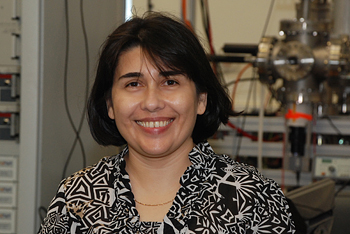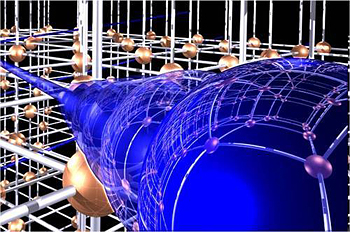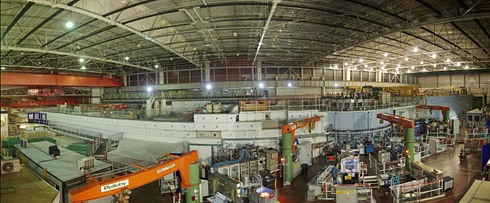Argument for stand-alone muon facility
Fri, 26 Apr 2013 10:52:00 BST
Researcher discovered muons can be produced in larger quantities at lower energy levels
 RESEARCH across a wide spectrum of science and technology would be given a huge boost by higher production rates and availability of muon particles, which are crucial to experiments that can lead to greater understanding of the structure of materials. Now, a scientist at the University of Huddersfield has published the findings of a project which discovered that muons can be produced in larger quantities at lower energy levels than previously believed.
RESEARCH across a wide spectrum of science and technology would be given a huge boost by higher production rates and availability of muon particles, which are crucial to experiments that can lead to greater understanding of the structure of materials. Now, a scientist at the University of Huddersfield has published the findings of a project which discovered that muons can be produced in larger quantities at lower energy levels than previously believed.
The discovery strengthens the campaign to construct a stand-alone muon facility, which would increase the number of experiments that could take place.
The physicist Dr Adriana Bungau is a research fellow at the University of Huddersfield and a member of its International Institute for Accelerator Applications. She is lead author of an article entitled Simulations of surface muon production in graphite targets, which appears in the new edition of the online journal Physical Review Special Topics – Accelerators and Beams, published by the American Physical Society (pictured below).
 Dr Bungau explains that her research was triggered by the growing demand for muon beam time from scientists using the “uniquely sensitive” technique known as MUSR – which stands for Muon spin rotation, relaxation and resonance. It has led to significant improvements in the understanding of the fundamental physical properties of superconductors, semiconductors and magnetic systems.
Dr Bungau explains that her research was triggered by the growing demand for muon beam time from scientists using the “uniquely sensitive” technique known as MUSR – which stands for Muon spin rotation, relaxation and resonance. It has led to significant improvements in the understanding of the fundamental physical properties of superconductors, semiconductors and magnetic systems.
Muon particles are often produced by the same accelerator-driven facilities that create neutrons, also vital for studies of materials. The world-leading facility is ISIS, at the Science and Technology Facilities Council Rutherford Laboratory in Didcot. To produce muon and neutron particles, proton beams are accelerated to an energy of 800 MeV. The muon target is reached first – the neutron target being 20 metres downstream. But only 4 per cent of the proton beam is used for muon experiments, with the remaining 96 per cent continuing through the accelerator to produce neutrons.
 Dr Bungau used simulation techniques to discover the optimum speed for a proton beam if it were used solely to generate muons. Her work showed that the greatest quantity was produced at the considerably lower energy of 500 MeV. Increasing the proton energy beyond this level resulted in little gain.
Dr Bungau used simulation techniques to discover the optimum speed for a proton beam if it were used solely to generate muons. Her work showed that the greatest quantity was produced at the considerably lower energy of 500 MeV. Increasing the proton energy beyond this level resulted in little gain.
The findings will surprise many. “Initially, we thought that if we go to higher energies we can go to higher production rates, but in this paper I have shown we can get higher muon rates at lower energy,” says Dr Bungau, whose simulations also suggest the best material and geometry of the target at which the proton beam is directed.
Pictured courtesy of ISIS Neutron Source's Twitter profile picture. Click here to view profile.
Lower energies and less complexity would result in cost savings and increase the number of MUSR experiments that could take place, if a stand-alone muon source were to be constructed. Dr Bungau is convinced that this is highly desirable, especially as the demand for muon beam time is increasing. Higher levels of muon production would enable the time required for experiments to be reduced from hours to minutes and physics, chemistry and biology are among the many disciplines that stand to benefit, explained Dr Bungau.
“Scientists at the leading-edge research laboratory, Fermilab, are already interested in our results and the impact they may have on the design of their next generation accelerator facility, Project X.”
Pictured below the world-leading facility ISIS, at the Science and Technology Facilities Council Rutherford Laboratory in Didcot.

- ‘Simulations of surface muon production in graphite targets’, by Adriana Bungau, Robert Cywinski, Cristian Bungau, Philip King, and James Lord Physical Review Special Topics - Accelerators and Beams 16, 014701. Click here to view.







